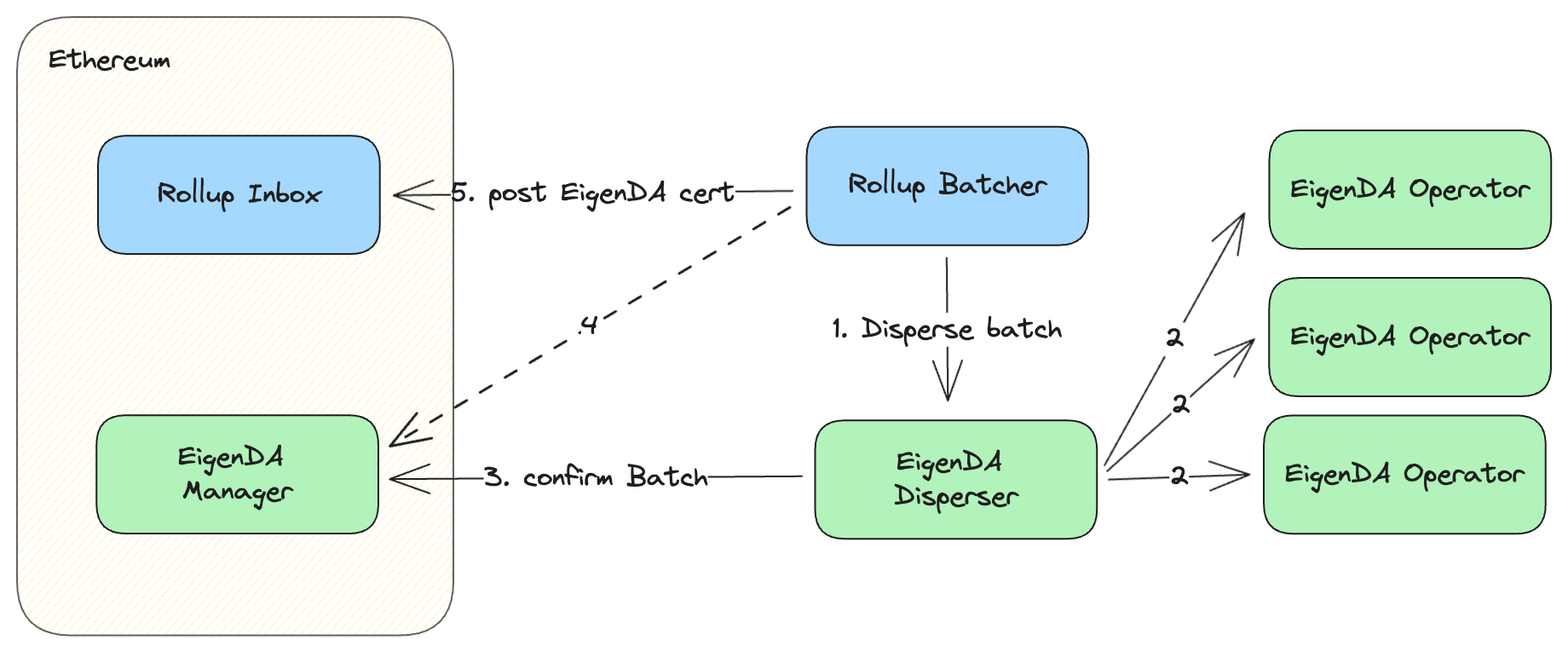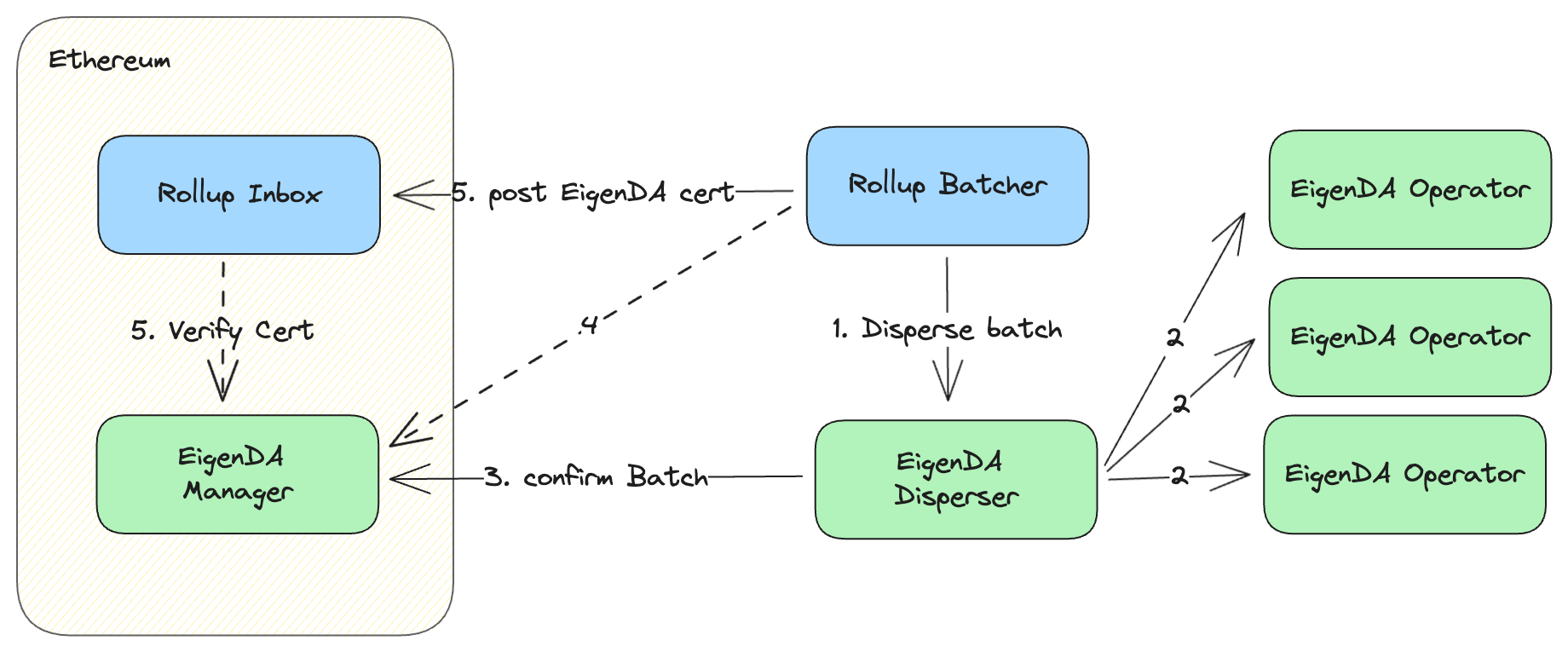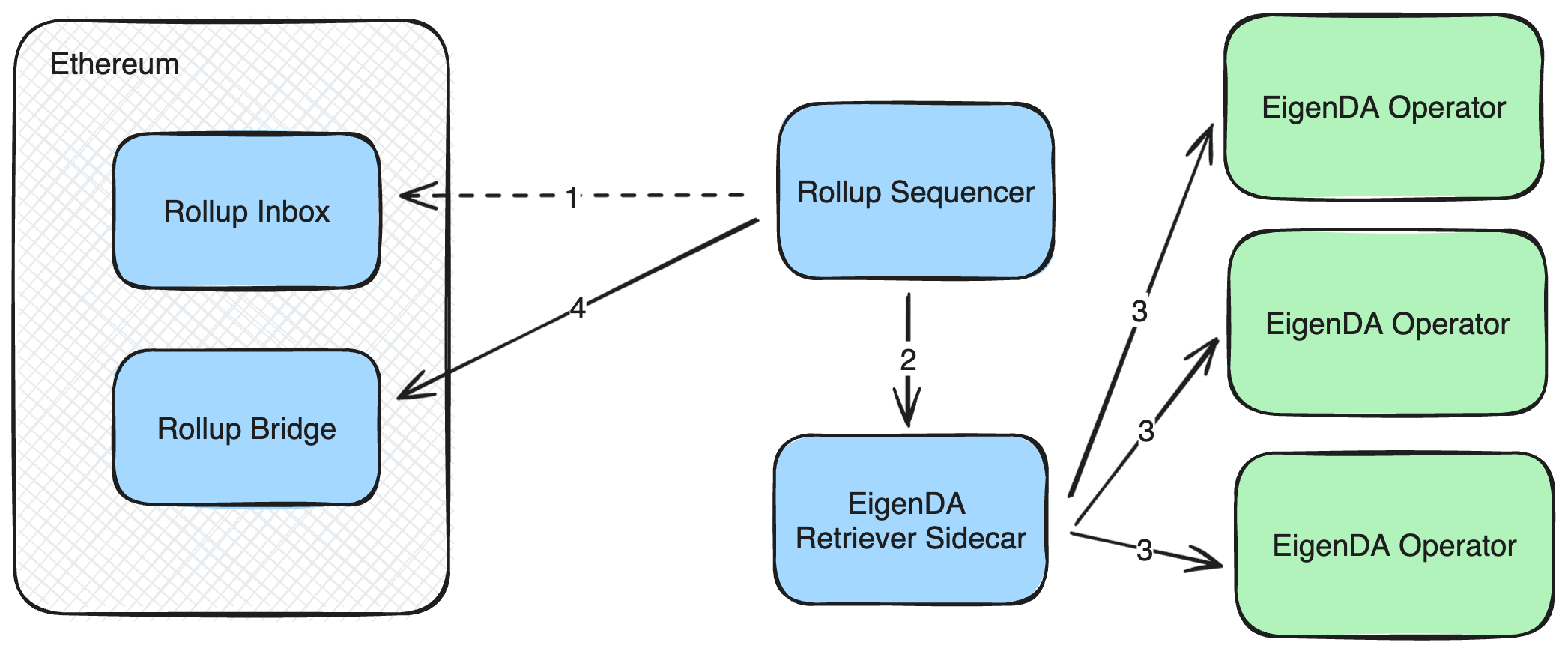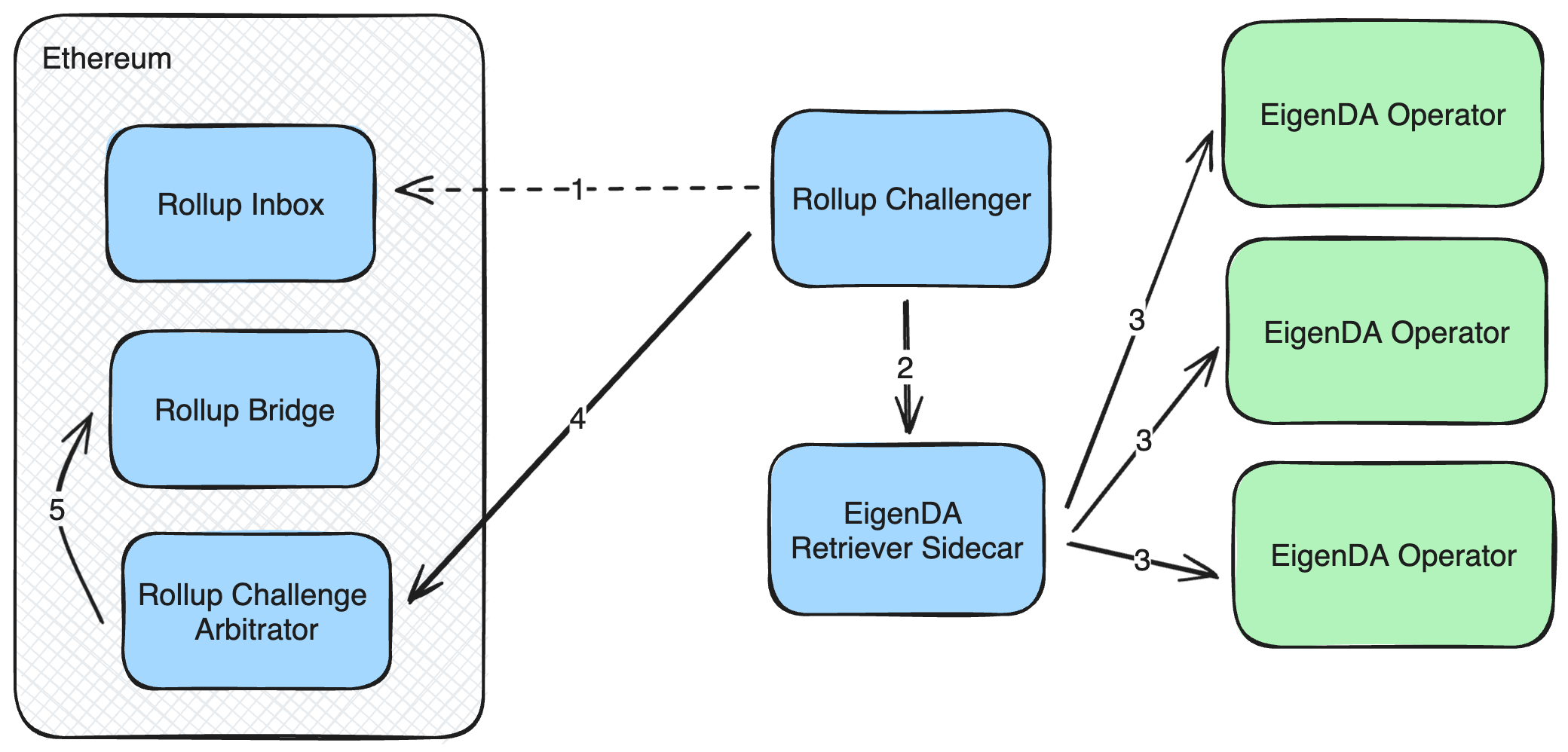Secure Integration Overview
This document aims to outline what a secure EigenDA integration looks like, to provide rollup engineers with a strong understanding of how an EigenDA integration would impact their tech stack and security model. For full details, see the EigenDA V2 integration spec.
Note: Each rollup stack uses slightly different terminology to refer to the same ideas. We try to use the most general language possible but might sometimes use stack-specific language for clarity.
For any given rollup there are five main concerns inherent to an integration with external DA:
- Dispersal. The rollup batcher must write transaction batches to the DA layer, wait for confirmation, and write the resulting DA certificate to the rollup inbox.
- Certificate Verification. Either the rollup inbox contract
or the rollup OS must verify that DA certificate is valid, i.e. that enough
operators have certified the blob available, before reading the DA cert's data
from the DA layer. This ensures that a transaction batch referenced by an
invalid certificate is not executed.
- Certificate Punctuality (Timing) Verification. The certificate must be posted to the batcher inbox within some punctuality window. EigenDA blobs are only available to download for 2 weeks, so this check is necessary to prevent malicious sequencers from posting certificates right before the blob gets deleted.
- Retrieval. Rollup full nodes must retrieve EigenDA blobs as part of the L2 derivation/challenge process. Otherwise they cannot keep up with the state of the L2.
- Blob Commitment Verification. The rollup's fraud arbitration protocol must be capable of verifying that every EigenDA blob used to generate a state root matches the KZG commitment provided in the EigenDA cert posted to the rollup inbox. In doing this verification, the chain ensures that the transaction data used to generate the rollup's state root was not manipulated by the sequencer/proposer.
A fully secure integration requires doing the 3 verification checks.
| Dispersal | Retrieval | Cert Verification | Blob Verification | Timing Verification | |
|---|---|---|---|---|---|
| Trusted | x | x | |||
| Fully Secured | x | x | x | x | x |
There are different strategies for implementing each of these checks, with different rollup stacks employing different strategies. We outline the different approaches in this document.
Trusted Integration (Dispersal+Retrieval)

The trusted integration trusts that the sequencer is verifying certs and posting them to the rollup inbox in a timely fashion. This integration focuses on dispersal and retrieval for the sake of simplicity, but at the cost of security. Let's walk through the lifecycle of an L2 batch:
- The batcher component of the rollup sequencer prepares an L2 batch, and calls the DisperseBlob() rpc on the EigenDA disperser, sending the batch data.
- The disperser erasure-encodes the blob into chunks, calculates the KZG commitment, and calculates the KZG proof for each chunk. It then distributes the chunks to the EigenDA operator set, where each operator receives a subset of the chunks in proportion to its stake. Each operator then stores the chunks its received, verifying that each chunk matches its KZG proof and KZG commitment. If so, it signs a message certifying that the chunk has been stored and returns it to the disperser.
- The disperser aggregates the signatures from step 3 into a single BLS signature and sends it and some blob metadata to to the EigenDA Manager contract on Ethereum. The EigenDA Manager contract on Ethereum is responsible for verifying EigenDA certificates, and if they verify, recording that verification in storage. Verification consists of ensuring the aggregated signature is valid and is based on the current EigenDA operator set. This blob verification status is not used in this implementation strategy.
- If the sequencer is using the EigenDA disperser, then it shouldn't just trust the disperser when it says that the blob has successfully been dispersed, it should verify by checking onchain. This is important in this integration strategy because the rollup inbox does not perform this check. Without this check the EigenDA disperser is trusted (in addition to the sequencer).
- The batcher then sends a transaction to the rollup inbox contract on Ethereum with the EigenDA blob id as calldata, which accepts the EigenDA blob id.
On the derivation side, there is a similar flow in reverse. When an L2 full node encounters an EigenDA certificate in the rollup inbox, it knows to retrieve the underlying blob from the EigenDA operator set using the EigenDA client, and then interpret the transactions inside.
Please keep in mind that this integration model is insecure. The rollup sequencer is completely trusted in this scenario, because the fraud proof system is disabled, and state roots cannot be challenged. This means the sequencer can post whatever state roots they want to the bridge contract and potentially steal funds.
Cert Punctuality Verification
EigenDA blobs are only available to download for 2 weeks, so it is important to ensure that the batcher is not posting EigenDA certs to the rollup inbox after the blob has been deleted. Each securely integrated rollup stack should have a cert-punctuality-window defined by its derivation pipeline.
Cert Verification
Cert validity rules are encoded in the EigenDACertVerifier contract. Cert validity can thus be checked offchain by making an eth-call, or onchain by calling the respective method. It can also be zk proven via a storage proof. See our V2 integration spec. Ultimately though, the L1 chain must be convinced that the cert is valid, which can either be done:
- Pessimistically
- verify in the rollup-inbox contract for every blob (optimistic rollups)
- create a zk proof which is aggregated and submitted along with the state transition correctness proof (zk rollups)
- Optimistically: only verify during one step proving if/when a fraud happens (optimistic rollups)
Although the pessimistic implementation is simpler, the optimistic approach is often desirable since verification only incurs on-chain costs when the sequencer is dishonest.
Pessimistic Cert Verification�
We only describe the inbox verification strategy here as it is mostly straightforward. There are many different ways to get a zk proof of storage, so teams wanting to use this approach should consult their relevant stack's guide.
Note: this strategy is only possible for rollup stacks whose rollup-inbox is a contract (e.g. arbitrum nitro). On the op stack, the batcher inbox is an EOA so it is not possible for it to make calls to the DACertVerifier (unless eip-7702 is used).
An instructive way to dive into the L2 inbox certificate verification strategy is to follow an L2 transaction from origination to finalization on Ethereum. We can further break this down into two stages, L2 chain finalization and L2 bridge finalization.
L2 Chain Finalization
First, L2 chain finalization. An L2 transaction is finalized with respect to the L2 chain when the transaction has been included in the rollup-inbox in a finalized L1 block. When this process is complete, any L2 node can say with confidence that the transaction is part of the canonical L2 chain and is not subject to a reorg. For example, if you were selling your car and a buyer paid you by sending you USDC on a secure rollup, it would be important to wait until the transaction had reached L2 chain finalization before letting them drive away with your vehicle.

The above diagram is the same as the trusted integration diagram above, with two slight modifications:
- In order to get a fully secured integration, the batcher should wait until the confirmBatch tx has been finalized onchain before posting the EigenDA cert to the rollup inbox. This is needed in order to protect from an L1 chain reorg that would remove/invalidate the eigenDA cert, while leaving the batch in the inbox.
- The rollup inbox contract is programmed not to accept the
EigenDA certificate unless it is valid. The cert is verified by making a call to the
verifyDACert()function.
At this point the user's transaction has been confirmed on the rollup. Once the weak subjectivity window passes (2 epochs ~= 13 minutes), the user's transaction can be considered finalized.
L2 Bridge Finalization

L2 bridge finalization is necessary for bridging assets or data from the L2 to the L1. Bridge finalization depends on the rollup bridge contract on the L1 arriving on an accurate L2 state root. This is where fraud or validity proofs come in.
Every L2 full node is responsible for deriving the L2's state root from the L1. In the absence of fraud, this is a relatively simple process with EigenDA:
- If an L2 full node reads an EigenDA cert from the rollup inbox, it knows this DA cert is valid because otherwise it would have been rejected from the inbox. So it uses the EigenDA client to retrieve the EigenDA blob using the EigenDA cert.
- The full node executes the L2 block as described in the L2 blob against the current L2 state.
- If the full node is a proposer/validator, it will post the state root of the L2 state to the rollup bridge contract on Ethereum every few blocks.
- If no fraud proof has been submitted within the challenge window (~7 days), then the state root in the rollup bridge contract is considered valid and any outbound assets or messages are released by the bridge contract.
In the event of a fraud challenge, the process is more complex. There is a second, equivalent state transition function for generating state roots which is much slower but also a much more rigorous fraud proof.
That process models the L2 state as a virtual machine, complete with an operating
system, which continuously reads messages from the rollup inbox contract using a
special ReadInboxMessage opcode, and handles them accordingly. If an inbox
message describes a batch of raw L2 transactions, the L2 OS knows it should
execute them. If an inbox message describes an EigenDA cert, the L2 operating
system knows that it should pass the KZG commitment inside the cert to the
special ReadPreImage opcode to read the underlying data, and then handle the
messages returned.
This VM state transition function process is useful because it makes it possible to rigorously prove that the state root was generated based on the exact data referenced by the EigenDA cert.
Let's walk through a scenario where the proposer is dishonest, in order to illustrate:

Note: this section uses arbitrum nitro opcode language. OP uses syscall opcodes to communicate with the preimage oracle instead.
- The proposer encounters an EigenDA cert and rather than reading data from EigenDA honestly, decides to read data from elsewhere, not committed to by the KZG commitment in the EigenDA cert. The proposer generates a state root on the basis of executing these messages, and posts this state root to the rollup bridge contract.
- A challenger sees that their state root for a given L2 block does not match the one posted by the proposer in the bridge contract, and makes a contract call to begin a challenge.
- The challenger and the defender alternate narrowing the scope of their
disagreement to a specific opcode of the VM state transition function, until
they've narrowed their disagreement to a specific opcode. In this case, the
challenge opts to challenge the
ReadPreImageopcode, since this is where the correct EigenDA should have been read. - The challenger invokes the arbitration contract with the necessary VM state
to execute the
ReadPreImageopcode, as well as necessary extra data for proving that the opcode was executed correctly. This extra data includes the chunk of data that should have been read (only 32 bytes of data are read at a time) as well as a KZG proof showing that the data matches the KZG commitment that the opcode was invoked with. The arbitration contract checks whether the data matches the KZG commitment and proof. - If the winner of the verification is the challenger then the old state root is replaced with the challenger's new state root.
In order to implement an EigenDA integration with fraud proofs, the underlying
rollup must support passing KZG commitments to ReadPreImage opcode. The rest
of the L2 VM design works as-is for arbitrating fraud.
Optimistic Cert Verification
The integration strategy under the V2 Blazar release is similar to the existing integration strategy, with the difference that EigenDA certificates are only verified on Ethereum if needed by the dispute game. This requires the certs to be verified within the L2 State Transition Function (STF). In this mode, a rollup batcher may submit invalid EigenDA certs to the rollup inbox, because L2 nodes interpret these invalid DA certs and discard them. If a rollup proposer submits a state root based on data referenced by an invalid EigenDA cert, it is possible to successfully challenge that state root.
This integration strategy depends on the ability of the L2 STF to validate EigenDA certs, which requires an authenticated view into the current EigenDA operator set. Specifically, the L2 STF must have access to L1 state roots, so that Eigenlayer contract storage proofs may be verified.
Blob Commitment Verification
A rollup must check that the EigenDA blob it received from EigenDA matches the KZG commitments in the cert. For full validation rules, see the spec.
There are a few different strategies possible for this:
- Recompute the KZG commitment and check it against the one in the cert. Straightforward but requires having the SRS points.
- Have someone provide an opening proof for the KZG commitment. See this issue for full details.
- For some zk rollups, the commitment posted onchain is of a different kind, and thus requires proving equivalence.